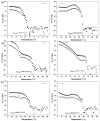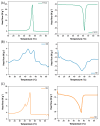Ultra-Long-Chain Sorbitol Esters Tailoring Thermo-Responsive Rheological Properties of Oleogels
- PMID: 40232106
- PMCID: PMC11941445
- DOI: 10.3390/foods14061030
Ultra-Long-Chain Sorbitol Esters Tailoring Thermo-Responsive Rheological Properties of Oleogels
Abstract
Oleogels must replicate the rheological behavior of saturated fats at processing and consumption temperatures to maintain their physical stability and sensory acceptance. Thus, multicomponent oleogels present a promising approach since oleogelators can exhibit structuring and melting at different temperatures. The aim of the study was to produce a mixture of ultra-chain-long esters capable of structuring and modulating rheological behavior in response to temperature exposure. Therefore, enzymatic transesterification between sorbitol and fully hydrogenated crambe oil (FHCO) was performed to produce a mixture of ultra-long-chain sorbitan esters (SB) for efficient structuring of sunflower oil. SB generated in a reaction medium consisting exclusively of ethanol (60 °C, 200 rpm, 1:1 molar ratio) was selected for its high sorbitol consumption (~95%). While SB oleogels exhibited higher gel strength at 5 °C, at 25 °C, FHCO oleogels were stiffer, showing the gradual melting of SB oleogels evaluated by temperature-dependent rheological analyses and thermal properties. Oleogelation inhibited hydroperoxide formation compared to sunflower oil over 30 days. Results highlight the potential of multicomponent oleogels based on ultralong-chain esters for healthier and more stable high-lipid products. Modulating rheological thermoresponsiveness ensures physical stability under refrigeration while providing a texture similar to saturated fats during spreading and swallowing.
Keywords: esters; oleogelator; rheology; saturated fat; transesterification.
Conflict of interest statement
The authors declare no conflicts of interest. The funders had no role in the design of the study, in the collection, analyses, or interpretation of data, in the writing of the manuscript, or in the decision to publish the results.
Figures








Similar articles
-
Unveiling the formation capacity of multicomponent oleogels: Performance of lecithin interacting with monostearate derivatives.Food Res Int. 2024 Jul;187:114430. doi: 10.1016/j.foodres.2024.114430. Epub 2024 Apr 25. Food Res Int. 2024. PMID: 38763679
-
Oleogels prepared with low molecular weight gelators: Texture, rheology and sensory properties, a review.Crit Rev Food Sci Nutr. 2023;63(23):6069-6113. doi: 10.1080/10408398.2022.2027339. Epub 2022 Jan 20. Crit Rev Food Sci Nutr. 2023. PMID: 35057682
-
Development and Characterization of Palm Oil-Based Oleogels Using Beeswax and Carnauba Wax as Healthier Beef Fat Mimetics.J Food Sci. 2025 May;90(5):e70241. doi: 10.1111/1750-3841.70241. J Food Sci. 2025. PMID: 40331723
-
Edible oleogels as solid fat alternatives: Composition and oleogelation mechanism implications.Compr Rev Food Sci Food Saf. 2022 May;21(3):2077-2104. doi: 10.1111/1541-4337.12928. Epub 2022 Mar 12. Compr Rev Food Sci Food Saf. 2022. PMID: 35279947 Review.
-
Formation, characterization, and application of natural bioactive phytosterol-based oleogels: A review.Food Chem. 2024 Oct 1;454:139821. doi: 10.1016/j.foodchem.2024.139821. Epub 2024 May 24. Food Chem. 2024. PMID: 38815329 Review.
References
-
- Davidovich-Pinhas M. Polymeric Gels. Woodhead Publishing; Cambridge, UK: 2018. Oleogels; pp. 231–249.
-
- Martins A.J., Cerqueira M.A., Fasolin L.H., Cunha R.L., Vicente A.A. Beeswax organogels: Influence of gelator concentration and oil type in the gelation process. Food Res. Int. 2016;84:170–179. doi: 10.1016/j.foodres.2016.03.035. - DOI
Grants and funding
- 2022/05719-2/Fundação de Amparo à Pesquisa do Estado de São Paulo
- 2021/09527-8/Fundação de Amparo à Pesquisa do Estado de São Paulo
- 2018/20308-3/Fundação de Amparo à Pesquisa do Estado de São Paulo
- 001/Coordenação de Aperfeicoamento de Pessoal de Nível Superior
- 403675/2021-9/National Council for Scientific and Technological Development
LinkOut - more resources
Full Text Sources

